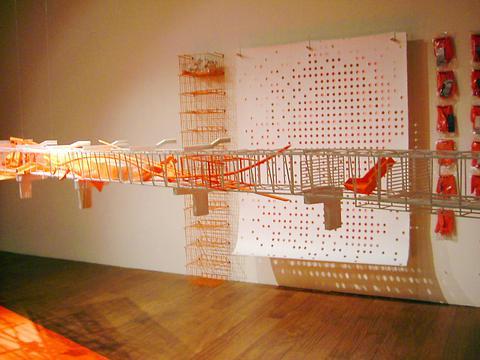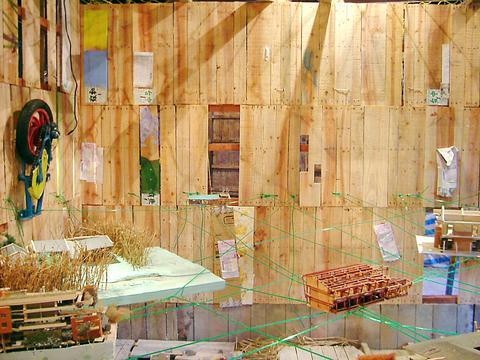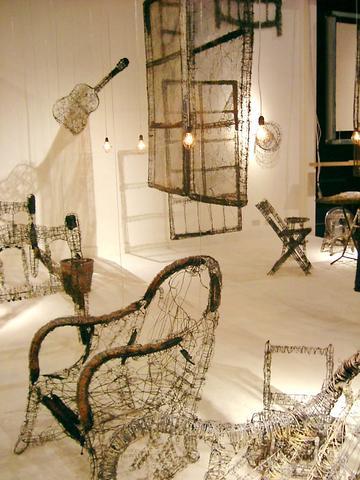Anew exhibition that examines Chinese architecture via history and literature Rumor of China Towns: Chinese Architecture 2004 curated by Ann Yu-Chien (
This is not a typically boring architectural exhibition filled with white foam-core models and framed Computer Aided Design (CAD) drawings. Instead, the work is innovatively presented like contemporary art: fun installations to look at while being thoroughly engaging and provocative.

An exhibition that deals specifically with Chinese architecture automatically brings to mind some of the research led by Rem Koolhaus. In his book Project of the City , an interesting statistic emerges: "There is one-tenth the number of architects in China compared with the US, designing five times the volume of projects. This implies an efficiency of 2,500 times that of an American architect."

PHOTO COURTESY OF SUSAN KENDZULAK
This exhibition not only alludes to the present frenzy of urbanization in the Chinese world, but refers back to historical events such as the nomadic raids on cities during Genghis Khan's 13th century reign and to the classic novel Dream of the Red Chamber by Cao Xueqin (
The first part of the exhibition relates to the novel's idyllic garden. Hong Kong-based Gary Chang (

Taipei-based Chien Hsueh-yi's (簡學義) Meta-architecture is a smartly installed presentation of small black-and-white slides of his projects, along with floor-to-ceiling projections. The projections themselves become a part of the room's architecture. Not only is the image a picture of his work, the image becomes a wall of the room, thus the work is continuously referring to itself as art, architecture, memory and structure.
Ilan-based Huang Sheng-Yuan's (黃聲遠) walk-through installations of plastic-covered wooden planks, net-enmeshed TV sets and a mish-mash of building detritus gives the effect of both a construction site and a disaster zone. The incredible ambiguous mess makes us question whether this is a "before" or "after" site and it is that uncertainty that gives this work such a seductive quality, as it has a sense of being lived in.
Also included are architects from China: Chang Yung Ho (
The more perilous works embody the "Yellow Peril" section: Lin Sheng-feng's (
However, the duo of Grace Chang(
While living in such a rapidly transforming environment, not only do architects have to respond immediately, but we, as responsible citizens, need to participate in the ongoing definition of our world.
Exhibition notes:
What: The Rumor of China Towns: Chinese Architecture 2004
Where: Museum of Contemporary Art (
Telephone: (02) 2552 3721
When: Until Jan. 16, 2005. Tuesday to Sunday, 10am to 6pm.
Details: Admission NT$50, www.mocataipei.org.tw

On April 26, The Lancet published a letter from two doctors at Taichung-based China Medical University Hospital (CMUH) warning that “Taiwan’s Health Care System is on the Brink of Collapse.” The authors said that “Years of policy inaction and mismanagement of resources have led to the National Health Insurance system operating under unsustainable conditions.” The pushback was immediate. Errors in the paper were quickly identified and publicized, to discredit the authors (the hospital apologized). CNA reported that CMUH said the letter described Taiwan in 2021 as having 62 nurses per 10,000 people, when the correct number was 78 nurses per 10,000

As we live longer, our risk of cognitive impairment is increasing. How can we delay the onset of symptoms? Do we have to give up every indulgence or can small changes make a difference? We asked neurologists for tips on how to keep our brains healthy for life. TAKE CARE OF YOUR HEALTH “All of the sensible things that apply to bodily health apply to brain health,” says Suzanne O’Sullivan, a consultant in neurology at the National Hospital for Neurology and Neurosurgery in London, and the author of The Age of Diagnosis. “When you’re 20, you can get away with absolute

May 5 to May 11 What started out as friction between Taiwanese students at Taichung First High School and a Japanese head cook escalated dramatically over the first two weeks of May 1927. It began on April 30 when the cook’s wife knew that lotus starch used in that night’s dinner had rat feces in it, but failed to inform staff until the meal was already prepared. The students believed that her silence was intentional, and filed a complaint. The school’s Japanese administrators sided with the cook’s family, dismissing the students as troublemakers and clamping down on their freedoms — with

As Donald Trump’s executive order in March led to the shuttering of Voice of America (VOA) — the global broadcaster whose roots date back to the fight against Nazi propaganda — he quickly attracted support from figures not used to aligning themselves with any US administration. Trump had ordered the US Agency for Global Media, the federal agency that funds VOA and other groups promoting independent journalism overseas, to be “eliminated to the maximum extent consistent with applicable law.” The decision suddenly halted programming in 49 languages to more than 425 million people. In Moscow, Margarita Simonyan, the hardline editor-in-chief of the